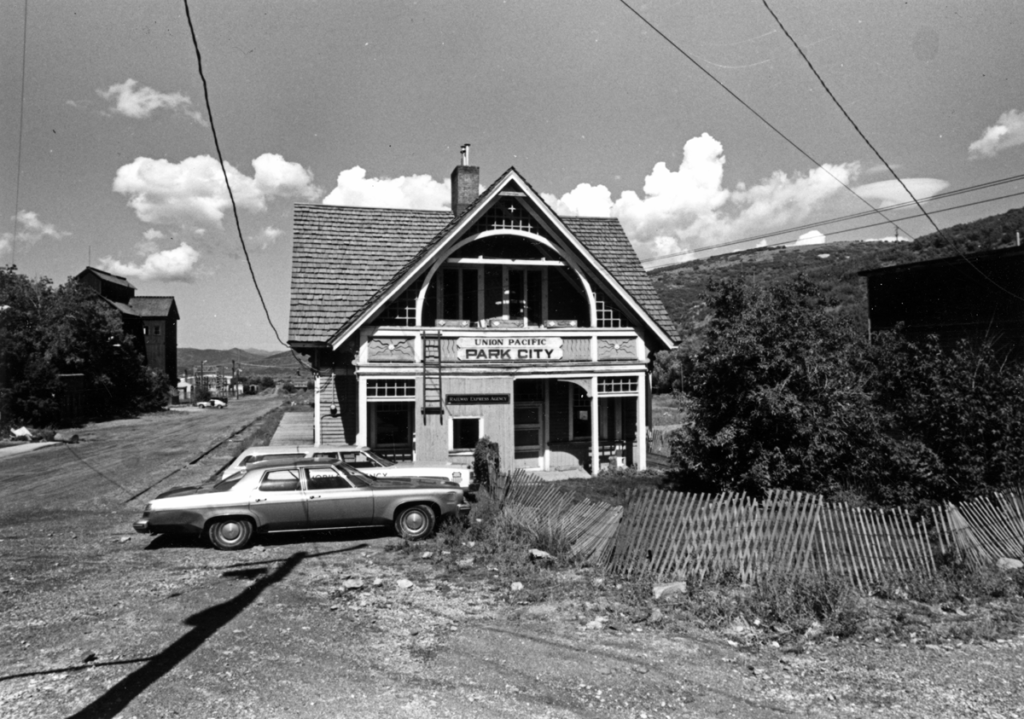After two decades of hard times during the 1950s and 1960s, Park City began to redefine itself from a mining town to a recreation destination. At the same time, the stars aligned nationally, statewide, and locally for the identification, preservation, and promotion of historic properties. The National Historic Preservation Act had been passed in 1966 followed by the Federal Reform Tax Act in 1976. The Utah Heritage Foundation was established and Utah’s State Historic Preservation Office opened. In Park City, the Historical Society, briefly operating in 1953, was revived, finding its community and voice.
Down the road in Coalville, residents awoke one morning in 1971 to find the picturesque 1879 Coalville Tabernacle razed by the LDS Church. News of this significant rural demolition made the New York Times and galvanized Utah preservationists. The Utah Heritage Foundation told Park City to pay attention to restoration “before it is too late” and said the “old buildings can be of vital interest to the traveling public.”
Demolitions slowed and restorations picked up steam. A family from Arizona purchased the two-story Hurley house in Old Town and restored it as a second home. Work began on the historic Buck house on Norfolk Avenue. The 1890 Ferry-Kearns mansion in Thaynes Canyon avoided demolition when the new owner moved it to the newly platted Holiday Ranch. Ogden native Bill Kimball, charmed that the historic Kimball Stage Lines once operated from the site of the derelict Eley Garage, bought the building and transformed it into the Kimball Art Center (currently Free People and We Norwegians). Keetley’s Union Pacific Depot was saved by moving it to Woodside Avenue in Park City, where it was restored by volunteers and turned into the Senior Center. Utah preservation architect Allen Roberts announced he was working on plans for ten Main Street facades and a feasibility plan was announced for the iconic Silver King Coalition Building to be developed into a retail center.
Phil Notarianni, a historian with the Utah Historical Society who had a soft spot for Park City, began nominating buildings to the National Register – the LDS Meeting House, St. Mary’s Catholic Church, Miner’s Hospital, Washington School, City Hall, Union Pacific Depot, Coalition Building, and 68 buildings making up the Main Street Historic District. The Park City Historical Society started conducting popular tours of historic buildings as part of Utah’s Preservation Week. The newly formed Convention and Visitor’s Bureau lured a national convention of the American Society of Travel Agents to town by showcasing local history and architecture.

Credit: Park City Historical Society & Museum, National Register Listing Photographs
Park City had been attracting young, energetic out-of-towners – many working at Park City Ski Area – who fell in love with the town and were vocal about saving it. They lobbied the city to return to Main Street the historic streetlights that had been replaced years earlier with “modern” surplus freeway lights and stacked behind the fire station. At a raucous council meeting, scores of old-timers opposed restoring the old lights while a newcomer said the city had “tried to make Main Street look like Heber.” In the end, the persistent young preservationists prevailed, and the freeway lights were replaced with the original lights, which remain to this day.
In 1977, Bill Coleman, who had arrived from Colorado, heard of an idea to bring a chairlift into town along the old ore tramway. Thinking that might be the key to revitalizing Main Street and saving several buildings, he and his friend Harry Reed, with others, devised a plan that included a chairlift, the Coalition and Union Pacific buildings, train cars turned into hotel rooms, and a Main Street trolley. Coleman felt Park City’s past “deserved to be preserved” and that the authentic setting would create a “romantic stage” for the ski industry. Although the project never came to be, elements of its visionary concept were actualized years later.
The City developed a plan for Main Street and Swede Alley improvements, adopted a Land Management Code, formed a Redevelopment Agency as a tool to help fund Old Town projects, and took possession of the Art Deco War Memorial Building from Summit County. But the Historical Society, led by artist and historian Pat Smith, felt the City was not doing enough and that ordinances did not address preservation. In 1979, Mayor Jack Green hired Salt Lake City planner Bill Ligety, known for his preservation and design skills, to direct Park City’s planning department and provide leadership for the building chaos to come. Ligety stated that historic assets were a valuable part of the town’s appeal and worth protecting.
In 1978 a developer presented plans to demolish the 1904 Miner’s Hospital turned Palace Flophouse and build condominiums. What happened next opened a whole new chapter in Park City’s story of historic preservation. Stay tuned for the story on the Miners’ Hospital preservation efforts.